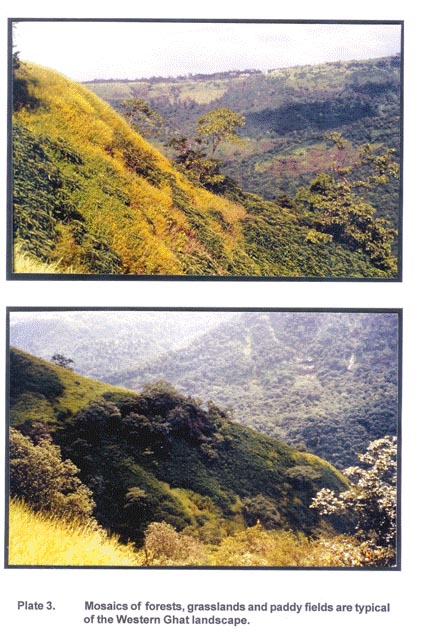|
Rarity of a community, habitat type and associated species is taken to confer high conservation value. Endemism reflects the restricted distribution of a species in its habitat which generally are specialized areas within the natural landscapes. Most endemic species are also generally rare because of their limited distribution. Developmental projects, over exploitation of species for consumptive use, trade or commerce and shrinkage of habitats are some of the factors that lead to the rarity of species. This criteria indicates the conservation significance of such habitats and species and has therefore been used for the evaluation of conservation values of project area particularly in the Ghat region.
Of the 4500 species of flowering plants reported from Western Ghats, 1788 species are endemic to Western Ghats. Of the 107 species of orchids from Western Ghats, 35% are endemic to Western Ghats and 15% are endangered. Of the 175 species of genus Impatiens, 77 are endemic to Western Ghat (Nair, 1991) and of the 21 palms in Western Ghats, nine are endemic.
The lists of plants collected from Khandala area by Fr. Santapau and other documented floral lists have been the sources of useful secondary information for the analysis of (Appendix VI, VII, VIII & IX) patterns of rarity and endemism in the plants occurring in the natural habitats within the project area and also in the surrounding landscape. Table 8 provides interesting facts of on endemism of some species in the Ghat section and the adjoining areas.
Table 8. Rare and endemic plants in the project area
| |
Species Name |
Status |
Distribution |
Remarks |
| Trees |
Erinocarpus nimmonni |
One of the 25 most rare & endangered sp. of Western Ghats. |
Khandala, Ambavane. Endemic to Western Ghats of Maharashtra and Karnataka |
The species represents a monotypic genus. Depletion of natural resource for developmental activities is mainly responsible for its rarity. |
| Herbs |
Nanothamus sericeus |
Rare |
Endemic to North Western Ghats |
|
| Achyranthes coynei |
Rare |
Distributed in Khandala (Pune district). Endemic |
So far known only from one locality |
| Bhidea burnsiana |
Rare |
Lonavale, (Pune), Mumbai & Ratnagiri. Endemic |
Originally collected from Lonavale |
| Dicanthium armatum |
Rare |
Western Ghats in Maharashtra. |
Distributed in only small areas of its localities |
| Dimeria blatteri |
Rare |
Western Ghats in Pune and Ratnagiri district. Endemic |
The species was collected from Lonavale and Khandala in 1918. Very restricted distribution. |
| Eriocaulon humile |
Vulnerable |
Khandala in Pune district. Matheran in Raigad district. Endemic. |
So far known from Western Ghats of Maharashtra only. Species was collected from Khandala in 1918. Habitat subjected to tourist pressure in Khandala. |
| Chlorophytum glaucum |
Rare |
Plateau and Ghat areas of South Western Maharashtra, Western Ghats. Endemic |
|
| Crotoleria filipes |
Rare and threatened |
Khandala and Konkan areas. Endemic to Western Ghats. |
|
| Delphinium dasycaulon |
Rare |
South Western Maharashtra |
Very restricted distribution. |
| Impatiens acaulis |
Rare |
South Western Maharashtra, (Amba, Phonda and Ambolighat). Endemic. |
|
| Herbs |
Sonerila scapigera |
Very rare |
Ghat area of South Western Maharashtra. Endemic. |
|
| Platenthera susaniae |
Very rare |
South Western Maharashtra. Ghat areas. |
Orchid, generally exploited for tubers by wild boars |
| Gloriosa superba |
Rare |
South Western Maharashtra |
|
| Gymnema khandlensis |
Vulnerable |
Raigad and Pune district, (Khandala and Masadi forests in Roha) Endemic |
So far known only from Maharashtra. The holotype was collected by Fr. Santapau in 1945 from Khandala. Later collections were made after 34 years from Raigad. Threats are biotic factors and tourists and traffic pressure. |
|
Oianthus deccanensis
|
Possibly extinct |
Maharashtra (25 km west of Pune along the Ghats). Endemic. |
First collection made in 1887, reported to be rediscovered later but no authentic records available. Extinction is probably due to drastic changes in its habitat. |
| Dicanthium compressum |
Rare |
Plains of Lonavale and Khandala in Pune district. Endemic to Maharashtra.
|
Forms a few scattered patches of grasses in Lonavale and Khandala. Recently also collected from Bhimashankar. |
| *Rotala ritchiei |
Vulnerable |
Reported from seasonal pond on Chakan-Alandi road, Pune in 1966. |
Collection from Pune district is the only collection made after type collection. Due to construction of highway (NH-4) along this area even this habitat has perished. |
| *Flemingia gracilis |
Rare |
Khandala and Lonavale in Pune, Matheran in Raigad and Karnataka. Endemic. |
Plants collected by Fr. Santapau in 1942 from Khandala and later from plateau in Lonavale in 1964. Last collected from Raigad in 1979. |
| Tripogon lisboae |
Rare |
South Western Maharashtra. Endemic |
|
| Climbers |
Ceropegia oculata |
Rare |
Found in Pune & Raigad district. Endemic to Maharashtra |
Causes of decline is forest clearing |
| Ceropegia lawii |
Endangered |
Endemic to Maharashtra State |
First reported in 1883 from Konkan and recollected nearly after a century in 1970 from Harishchandragad Hill. Tubers consumed by natives account for its extreme rarity in wild. |
| Ceropegia evansii |
Vulnerable |
So far known only from Khandala and neighbouring Amba valley, Pune district. Endemic to Maharashtra State. |
Since 1964, it has not been collected inspite of repeated efforts. Tubers are consumed by natives and their consumption is a major threat for its wild population. |
| *Ceropegia sahyadrica
|
Rare |
Ambolighat, Khandala, Amba valley. Endemic to Maharashtra State. |
First time collected in 1902 and 1919 from Khandala and not reported since then. Consumption of tubers and destruction of habitat appears to be a cause of its rarity. |
(* Not included in the appended checklist)
Information Source:
Red Data Book of Indian Plants (1987), (eds) M.P. Nayar and A.R.K. Sastary. Published by Director, Botanical Survey of India, Calcutta. Vol. I, II & III.
Sanjappa, M (1991). Proceedings of the Symposium on Rare, Endangered and Endemic Plants of the Western Ghats. Kerala Forest Department (KFD), Wildlife Wing.
Sule, R (1991). Proceedings of the Symposium on Rare, Endangered and Endemic Plants of Wester Ghats. Kerala Forest Department (KFD) Wildlife Wing.
Some of the plants that have medicinal value are Alstonia scholaris, Barleria prionitis, Cissus woodrowii, Dalbergia sympathetica, Entada pursaetha, Gloriosa superba, and Exacum bicolor. These also have rare status on account of their utilisation for medicinal purposes (Sadhale, 1991).
An analysis of the patterns of faunal distribution and endemism in the Western Ghat suggests high levels of species richness and endemism associated with stable climatic conditions, and a variety of habitats created by the diversity of physiographic features and vegetation types supported on varied landscapes (Plate 3). The most remarkable features of endemism are particularly reflected by the number of endemic amphibian species. Almost 70% of the amphibian species are endemic to Western Ghats (Daniels, 1992). Fourteen species of Rana are endemic in Western Ghats (Mani, 1974). An endangered amphibians Indotyplus battersbyi is orginally described from Khandala region of Pune district.
Patterns of endemism are also very pronounced in mammalian fauna. This is particularly reflected by several endemic species of Giant squirrels, and non-human primates which have restricted distribution within the Western Ghat forest ecosystem. Several birds restricted to canopy are also endemic to Western Ghats. It could not have been possible to undertake faunal surveys during the reconnaissance of the project area yet information on the occurrence of several species do indicate that rapid development of area due to introduction of railway followed by industrialisation have pushed several faunal species to the list of endangered species.
|










